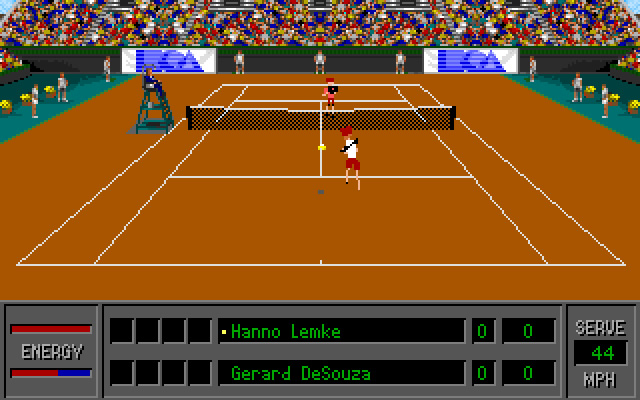Is World Tour Tennis the unsung forefather of today’s racquet sims or merely a weird late-DOS footnote you’d expect to find buried beneath shareware disks at a flea-market table? (Rhetorical question. Self-answer: both, Schrödinger’s topspin.) This 1993 EA re-issue of Distinctive Software’s 1990 4D Sports Tennis re-packages the studio’s wireframe physics engine with a beefed-up world-tour season, two broadcast camera angles, and enough stat pages to make an accountant scream “love-forty.” Underrated? Absolutely, most players gave up the moment the coat-hanger athletes emerged from DOS darkness. Overrated? Only if you worship flat-shaded limbs. Fundamental? Maybe not, but skipping it means missing a design experiment that dared to model backspin when polygon sports were still novelties.

Historical Context
Originally launched as 4D Sports Tennis in 1990, Distinctive’s vector-engine showcase impressed tech nerds but looked crude next to sprite-heavy console titles. EA bought Distinctive in ’91, re-branding it EA Canada and plotting a trilogy: a straight port (4D Sports Tennis), a sponsorship repaint (Compaq Grand Slam Cup), and 1993’s expanded re-issue, World Tour Tennis . The update arrived just as PC sports games leaned toward licenses, FIFA was weeks away, leaving wireframes feeling quaint yet curiously technical.
I discovered the game on a MicroCenter demo rig flanked by laser-disc shooters. The clerk called it “a physics test wearing wristbands.” Challenge accepted. Four disks later I spent Labor Day weekend double-faulting on a 386 that hummed louder than Sampras’s serve.
Mechanics
Wireframe Court Craft
Every player is a bundle of polygons, but timing rules everything. Movement sits on the numeric keypad; Ctrl plus direction chooses lob, slice, or topspin. Distinctive’s engine swaps discrete animation frames at about 25 fps, whiff early, your racket freezes mid-arc; swing late, the ball tattoos your chest. Crowd backdrops debut here: low-res fans sway like cardboard cut-outs while surface colour dictates physics. Grass stays slick, clay drags the ball into slow, high kicks, and indoor carpet lands in neutral territory. The manual never quantifies bounce percentages, but you feel the pace swing dramatically when you import your grass-court cannon onto red dirt.
Sound is classic AdLib: serves pop, crowds hiss, and the umpire’s digitized “advantage” occasionally warbles into what my teenage ears always heard as “avalanche” (subjective glitch, don’t @ me).
Modes: Practice to Planet
Apart from one-off exhibitions and a ball-machine practice mode, the revamped World Tour season is the star. You sculpt a rookie, gender, dominant hand, backhand grip, then start dead last in a ladder of 96 ranked opponents with a modest bankroll for tickets and entry fees. Over sixty tournaments dot the world map, from Harare hardcourt futures to fictional Slam equivalents. Choose tournaments carefully: long flights sap stamina points and burn cash. Training weeks let you shift stat sliders for serve speed, volley accuracy, and footwork; racquet upgrades add sweet-spot tolerance or spin intensity.
Scheduling becomes the meta-game. Skip early challengers and you lack points to enter majors; over-commit onto clay and your baseline bruiser might stumble on Wimbledon’s grass. Nothing is licensed, yet the facsimile names amuse: “Pete Stamps,” a serve-volley beast; “Stef Edborg,” a net maestro; “Monica Rollover,” a relentless topspinner.
Two Viewpoints, No Motion Sickness
The engine offers two stable angles: baseline and broadcast. Baseline sits behind your avatar, optimal depth, minimal FOMO. Broadcast rotates ninety degrees overhead, echoing TV coverage. Early previews teased a ball-tracking cam, but the retail build never shipped it. Baseline loyalists cite timing clarity; broadcast devotees love seeing sideline geometry. Either way, the Z-buffer rarely misplaces polygons, though an occasional racket-inside-ball overlap can gift phantom winners.
Multiplayer by Modem
EA touted modem play, 2400-baud, null-modem cable, or IPX LAN, though practical success demanded matching IRQs and saintly patience. My buddy Rob and I once blew an $18 long-distance bill to simulate Monaco quarter-finals; the line desynced at 4-4 in the third. Rage subsided; bragging rights endured.
Legacy and Influence
Wireframe graphics doomed World Tour Tennis to niche status when texture-mapped 3-D rolled in, and EA shelved further tennis projects to chase hockey and soccer gold. Yet the game’s DNA lingers: its global-calendar career is a clear ancestor to Top Spin and Virtua Tennis tours, and its surface-dependent physics informed Dreamcast designers at SEGA when they tuned grass and clay sliders. Even the two-button timing model echoes through modern sims, proving Distinctive solved the “pure timing” riddle long before analog sticks.
A tiny cult keeps the ball in play. DOSBox vets share timing charts on Reddit; speedrunners race to sweep all four fictitious Slams in under 45 minutes using corner-serve exploits; modders patch .EXE files to overlay real player photos, a nightmare for nostalgia but a triumph of hex hacking.
Closing Paragraph + Score
Booting World Tour Tennis today is like unsealing a wireframe time capsule: primitive visuals, yes, but timing windows tight enough to train reflexes and a career mode that still lights up the spreadsheet lobe of my brain. Serve-slice-charge at the net correctly and you’ll feel the ancestors of every modern tennis sim clicking into place. Miss, and the coat-hanger athlete shanks a ball into oblivion, reminding you why EA changed course.
Final Score: 7.2 / 10.0, not a Grand Slam champion, but a scrappy qualifier that invented clever mechanics, passed the racket to flashier successors, and never quite double-faulted on fun.